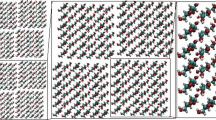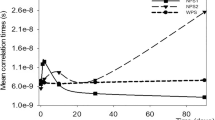Conclusions
The results of the experimental investigation of a moist organic composite by high-resolution NMR and DTA indicate a change in the structure of water, due to an interaction between the water molecules and the macromolecules when water is sorbed by the organic polymer. A part of the sorbed water molecules is strongly bound to the macromolecules; their mobility is very low and is not recorded by high-resolution NMR. As the moisture content of the composite increases, molecules of water appear, the mobility of which is intermediate between the strongly bound and free water molecules in the macrospace. This part of the molecules is represented in the NMR spectrum by a broadened and shifted line and a shift of the endothermic peak towards lower temperatures is observed on the thermal analysis diagrams. The weakly bound water can be detected in the composite starting at a moisture content of 5–8%.
Similar content being viewed by others
Literature cited
V. N. Bulmanis, N. S. Popov, T. A. Starzhenetskaya, S. A. Kuz'min, G. I. Milyutin, and V. I. Polyakov, “Influence of sign-changing thermal cycles and moisture on the strength of wound glass fiber plastics and organic composits,” Mekh. Kompozitn. Mater., No. 6, 1045–1051 (1988).
S. D. Garanina, G. S. Shul', L. B. Lebedev, L. M. Shkirkova, L. A. Shchukina, M. A. Ermolaeva, and G. P. Mashinskaya, “Influence of water on the properties of organic composites,” Mekh. Korapozitn. Mater., No. 4, 652–656 (1984).
A. N. Aniskevich, “Sorption of moisture by a unidirectional organic composite at stationary temperature-moisture conditions,” Mekh. Kompozitn. Mater., No. 3, 524–530 (1986).
H. E. Bair, G. E. Johnson, and R. Merriweather, “Water sorption of PK and its effect on the polymer's dielectric behavior,” J. Appl. Phys.,49, No. 10, 4976–4984 (1978).
Water in Polymers [in Russian], Moscow (1984).
Water in Food Products [in Russian], Moscow (1980).
V. V. Mank and N. I. Lebovka, Nuclear Magnetic Resonance Spectroscopy of Water in Heterogeneous Systems [in Russian], Kiev (1988).
J. E. Carles and A. M. Scallan, “The determination of the amount of bound water within cellulosic gels by NMR spectroscopy,” J. Appl. Polymer Sci.,17, No. 6, 1855–1865 (1973).
N. P. Bogdanova, G. B. Buzanov, N. N. Usov, and O. V. Plotnikov, “Study of the interaction of fibrous materials with water by high-resolution1H NMR,” in: Investigation and Optimization of Processes of Textile Technology [in Russian], Riga (1986), pp. 41–47.
A. N. Aniskevich and N. E. Khramenkov, “Investigation of the influence of water on the properties of an organic composite by thermoanalytical methods,” Mekh. Kompozitn. Mater., No. 5, 911–916 (1989).
V. V. Mank and O. D. Kurilenko, Investigation of Intermolecular Interactions in Ion-Exchange Resins by NMR [in Russian], Kiev (1976).
Author information
Authors and Affiliations
Additional information
Translated from Mekhanika Kompozitnykh Materialov, No. 2, pp. 317–320, March–April, 1990.
Rights and permissions
About this article
Cite this article
Matis, I.G., Kerch, G.M. & Aniskevich, A.N. Investigation of the state of water sorbed by an organic polymer by high-resolution1H nuclear magnetic resonance and differential thermal analysis. Mech Compos Mater 26, 259–262 (1990). https://doi.org/10.1007/BF00612330
Received:
Issue Date:
DOI: https://doi.org/10.1007/BF00612330




